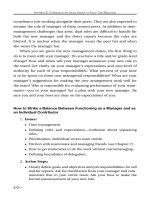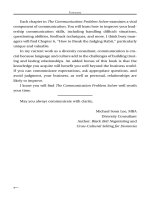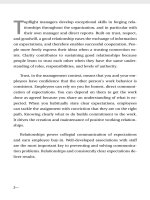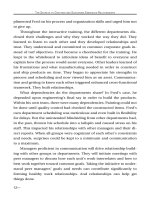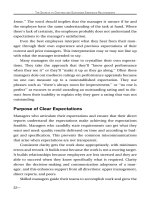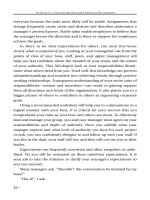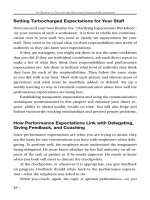The Communication Problem Solver 19 doc
Bạn đang xem bản rút gọn của tài liệu. Xem và tải ngay bản đầy đủ của tài liệu tại đây (77.6 KB, 10 trang )
H
OW TO
U
SE
Y
OUR
P
ROCESS
S
KILLS TO
P
REVENT AND
S
OLVE
C
OMMUNICATION
P
ROBLEMS
> Offer training in communication, conflict resolution, and team
building.
> If behavior does not change, contact HR for next steps regarding
counseling and documentation requirements.
F. Managing Up
When the Relationship Is Going Well
Your relationship with your boss can lead to your success or to problems.
Many managers make the mistake of waiting for the boss to take the
initiative. The care and feeding of a reporting relationship involves both
of you. Maintaining a good working relationship does not happen by
accident. You must demonstrate your strength and confidence in your
abilities by managing the relationship with your manager—even when it
is going well.
1. Issue: How to manage the relationship with your manager when
the relationship is going well.
2. Problem definition/facts: You have no problems and want to
keep it that way. The manager wants to prevent problems by managing
up.
3. Action steps:
> Clarify your roles, responsibilities, and levels of authority (see
Chapter 2). Know your manager’s expectations and work within
that realm.
> Establish a framework of goals/objectives and your method and
frequency of communication. Can you meet weekly to discuss
progress and plans? Keep your agreements on method and fre-
quency of communication.
> Create a shared vision of what success looks like in detail. Go
through potential examples. Walk through how the idea might get
done.
> Assess where you are today vis-a
`
-vis goals/objectives. Meet all
goals or give early warning of why they won’t be met with back-
up plans of work-arounds.
162—
C
OMMON
P
EOPLE
P
ROBLEMS
—A H
ANDY
R
EFERENCE
> Present your plans and goals for your group earlier than your
deadline. Be sure to indicate how they dovetail with your manag-
er’s goals and the overarching organizational goals.
> Send e-mail ahead of a one-on-one meeting with the agenda to
give your manager time to think. Be prepared for routine progress
meetings. Work from agendas/lists.
> Be considerate of your manager’s time-management challenges.
Be brief and brilliant. Give a high-level overview of the major
points you would like to brief the manager on. Give only the de-
tails that the manager is interested in hearing at the time.
> Address the manager’s needs. Remind your manager of what he
committed to and offer to help deliver it.
> Be clear about what your manager has to communicate up and
provide the necessary information or results on time.
> Be factual when presenting what your group needs. Back it up
with evidence.
> Balance your manager’s expectations with those of your direct
reports. Support your group when you represent their accom-
plishments and needs to your manager. Get answers for them
when needed.
> Discuss with your manager any variations in each other’s styles
and how you can best adapt to get the best communication re-
sults. Flex your communication style to best meet your boss’s
needs.
> Tailor what/how to communicate and how often so that commu-
nications meet the manager’s needs.
> Discover what your manager’s hottest topic is and be conversant
on it.
> When you need approval or a decision, be thoroughly prepared
with your recommendation, rationale, costs, benefits, opportuni-
ties, and potential problems. Think ahead about the questions
your manager might ask and include the answers in your recom-
mendation. Have a back-up alternative ready.
> If your manager is working remotely, the challenges are different.
You need to take the initiative to speak more frequently despite
time zone obstacles.
—163
H
OW TO
U
SE
Y
OUR
P
ROCESS
S
KILLS TO
P
REVENT AND
S
OLVE
C
OMMUNICATION
P
ROBLEMS
When the Relationship Is Not Going Well
Sometimes the relationship with your manager has not been developed,
or it got off to a tough start. If so, it is up to you to decide on a plan to
create a good working relationship with your manager. Don’t wait for
the manager to take the initiative. You cannot be successful without part-
nering with your manager.
This holds true even if your manager is ineffective or incompetent.
I’ve witnessed situations where exceptionally competent people left or-
ganizations because they did not realize it was their responsibility to
manage the unhappy relationship with incompetent or ineffective
bosses. Since their boss’s problems were well known throughout the or-
ganizations, they thought they would be covered. In fact, the people who
did not manage up in adversity were perceived as having diminished
organizational influence and power.
It’s not only to your benefit to manage up in a difficult relationship,
it is your responsibility to yourself, your staff, and your organization to
initiate repair of the relationship and to manage the relationship with
your boss.
1. Issue: How to manage the relationship with your manager when
the relationship has problems or your manager is not effective.
2. Problem definition/facts: The boss makes unreasonable requests
and gives unreasonable deadlines/goals. She requests something outside
the scope of the job. Expectations and priorities are inconsistent and
change from day to day. There are no written goals or deadlines. Staff
feel intimidated because of her poor word choice and tone of voice. She
tries to motivate people in a negative way instead of with positive recog-
nition. She does not acknowledge job success. Her feedback does not
match verbal goals. The impact of her behavior is loss of dollars due to
people leaving, low morale, and low productivity.
3. Action steps:
> State your intention to work well together and to support her
goals. Tell her of your need for clear expectations and directions.
Relate this to how it impacts her goals.
164—
C
OMMON
P
EOPLE
P
ROBLEMS
—A H
ANDY
R
EFERENCE
> Ask for clarification on what needs to be accomplished. Ask for
more structure, including written goals, so you can be sure to
meet her expectations. Request prioritization of all projects and
tasks. Clearly define responsibilities and priorities and give her a
copy in writing. Clarify any misunderstandings right away and
correct the written document.
> When she changes expectations, restate what was originally
agreed upon—scope, goals, and deadlines. State what has changed
and when it changed. Discuss inconsistent expectations. Ask for
clarification and write up.
> Suggest that for ‘‘best results’’ more resources are needed (use
statistics, failure data, historical data, person-hours needed to do
tasks, and what other work is not getting done).
> Give your manager frequent status updates—overload with infor-
mation until she tells you she wants less. This gives her the oppor-
tunity to give you frequent feedback so you will know where you
stand.
> Suggest roundtable feedback with your manager and your team.
> Say how loss of teammates is impacting the work.
> Tell her what you are hearing from the team and express the de-
sire to work together to improve the situation.
> Make specific suggestions and clarify your manager’s needs. Ask
specifically what you can do to help the situation.
> Meet with your boss’s manager as a last resort if nothing works.
G. Handling Organizational Concerns
Handling Your Group When the Organization Has Problems
Organizational obstacles can hamper your team’s progress and cause
stress and frustration. You might want to look back at Chapter 3, ‘‘Com-
municating Your Expectations: What to Say and How to Say It,’’ for more
information on organizational obstacles. The ‘‘Six Communication Prob-
lems Arising from Unmet Expectations’’ section of Chapter 3 gives sev-
eral specific concrete examples of what organizational obstacles are and
how to handle them.
—165
H
OW TO
U
SE
Y
OUR
P
ROCESS
S
KILLS TO
P
REVENT AND
S
OLVE
C
OMMUNICATION
P
ROBLEMS
1. Issue: What to do when the organization has problems.
2. Problem definition/facts: Problems beyond the employees’ con-
trol prohibit maximum productivity.
3. Action steps:
> Identify the problem and discuss it with your boss first. How does
the obstacle impact the work your group is trying to accomplish?
How does it impede it?
> Talk in the language of your team’s action plans and goals.
> Identify who can make decisions regarding possible solutions.
> Work back and forth with your boss to provide possible solutions
to the organization.
> Be truthful with your group about the problem. Sometimes no
organizational change is appropriate and the group needs to work
around the obstacle.
> Stick to facts and do not give opinions unless they are to advance
a solution. Especially do not grouse or complain, as that invites
morale problems.
> Keep a positive approach and don’t give up.
> Keep trying to solve the problem and inform your employees of
what you are doing.
> Act as a role model and encourage patience and perseverance in
spite of obstacles.
Summary
People problems are just business problems enveloped in concerns
about interpersonal communication or about how to handle conflict
among people. People problems can be cloaked in emotion and this
makes them challenging. The simple process in this chapter helps man-
agers dig down to the business facts and observed behaviors related to
the work. This chapter relies on both the importance of relationship and
an easy, three-step solution process.
In preventing and solving people problems, the manager’s intention
to preserve the working relationship is essential. So is the intention to
166—
C
OMMON
P
EOPLE
P
ROBLEMS
—A H
ANDY
R
EFERENCE
discover the truth of both the work issue and the accompanying inter-
personal issue. By describing the problem and facts, the manager can
more easily solve the problem.
Next, Part III shows the importance of collaborative conversations
in feedback, coaching, delegation, and listening. When you lead these
management activities collaboratively, they prevent people problems.
Each of these chapters pulls on the power of both relationship and hav-
ing a repeatable process to follow and adds the dimension of collabora-
tion.
—167
This page intentionally left blank
PART
III
LEADING COLLABORATIVE
CONVERSATIONS
P
art III addresses feedback, coaching, delegating, and listening.
These dialogues offer critical opportunities for the manager
to energize direct reports about assignments. When you give
feedback, you’re collaborating. When you coach, you’re collaborat-
ing. When you delegate, you’re collaborating. When you listen,
you’re collaborating. Part III shows you how to do it.
How do Part I (‘‘The Secrets to Creating and Sustaining Ener-
gized Relationships’’), Part II (‘‘How to Use Your Process Skills to
Prevent and Solve Communication Problems’’), and Part III (‘‘Lead-
ing Collaborative Conversations’’) interconnect? When a manager
has developed a close working relationship with an employee and a
process is in place, he or she is positioned to lead a collaborative
conversation.
The relationship is key to a successful collaborative conversa-
tion. The manager depends upon the relationship to set the envi-
ronment for a frank, open talk about the work expectations and the
observed progress toward those goals. When the relationship is in
place, there is greater opportunity for honesty about what has oc-
curred to date and how to continue or make midcourse changes so
the employee can produce a successful outcome.
Both people listen with greater give-and-take when the relation-
ship is solid. They have more desire to understand the issues as
intended by the other person. New information can be learned, and
each person can redirect his or her focus, if needed.
Process is equally valuable to the success of the collaborative
conversation. When process is delineated, each person can lean on
the structure to define terms and examine the alternatives for future
170—
action. This provides a common vocabulary and set of expectations,
both of which facilitate collaborative conversation.
Partnership Behaviors
For feedback to be absorbed and applied, a collaborative discussion,
in which the employee explores the issue and best alternatives,
yields the most ownership of solutions going forward.
Collaborative conversations require the intention to develop
partnerships. The manager leads this by demonstrating partnership
behaviors. Working toward win-win outcomes, or mutual success, is
critical. Try to answer why changing the way the employee does
things will benefit him in the short and long term. How will such
change help him achieve goals, and why should the employee care?
On the other hand, does the employee have a better way of achiev-
ing the goal than the manager? Is there a third way to best benefit
the needs of the organization that emerges through collaborative
conversations?
Partners value the opinions of the other partner and appreciate
their ideas on an equal basis. They recognize one another’s talents,
contributions, and knowledge. Associates are willing to learn from
one another, listen to each other, and work as a team for mutual
achievement. They share ownership of a goal.
An effective partnership builds on complementary knowledge,
skills, and functional expertise. It creates common processes and
vocabulary to enhance communication and goal accomplishment.
Partnership is an opportunity to build and grow the working rela-
tionship for each other’s benefit as well as the organization’s.
—171


